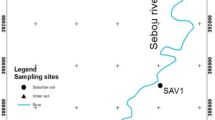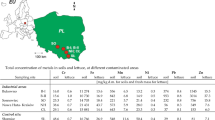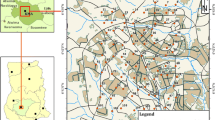Abstract
Fifty-seven samples of soils commonly ingested in South Africa, Swaziland, Democratic Republic of Congo (DRC), and Togo were analyzed for the concentrations of arsenic (As), cadmium (Cd), cobalt (Co), chromium (Cr), copper (Cu), lead (Pb), manganese (Mn), nickel (Ni), and zinc (Zn) and their bioaccessibility in the human gastrointestinal tract. Bioaccessibility values were used to calculate daily intake, and hazard quotient of each trace element, and chronic hazard index (CHI) of each sample. Carcinogenic risk associated with As and Ni exposure were also calculated. Mean pseudo-total concentrations of trace elements in all samples were 7.2, 83.3, 77.1, 15.4, 28.6, 24.9, 56.1, 2.8, and 26.5 mg/kg for As, Cr, Mn, Co, Ni, Cu, Zn, Cd, and Pb, respectively. Percent bioaccessibility of Pb (13–49%) and Zn (38–56%) were highest among trace elements studied. Average daily intake values were lower than their respective reference doses for ell elements except for Pb in selected samples. Samples from DRC presented the highest health risks associated with trace element exposure with most of the samples having CHI values between 0.5 and 1.0. Some samples had higher than unacceptable values of carcinogenic risk associated with As and Ni exposure. Results indicate low trace element exposure risk from ingesting most of the soil samples.



Similar content being viewed by others
References
Root-Bernstein RS, Root-Bernstein MR . Honey, Mud, Maggots, and Other Medical Marvels. Pan: London. 2000.
Abrahams PW, Davies TC, Solomon AO, Trow AJ, Wragg J . Human geophagia, calabash chalk and undongo: mineral element nutritional implications. PLoS One 2013; 8: e53304.
Mathee A, Naicker N, Kootbodien T, Mahuma T, Nkomo P, Naik I . A cross-sectional analytical study of geophagia practices and blood metal concentrations in pregnant women in Johannesburg. S Afr Med J 2014; 104 (8): 568–573.
Songca SP, Ngole VM, Ekosse GE, De Jager L . Demographic characteristics associated with consumption of geophagic clays among ethnic groups in the Free State and Limpopo provinces. Indilinga Afr J Indigen Knowl Syst 2010; 9: 110–123.
Geissler PW, Mwaniki DL, Thiong’o F, Michaelsen KF, Friis H . Geophagy, iron status and anaemia among primary school children in Western Kenya. Trop Med Int Health 1998; 3: 529–534.
Geissler PW, Shulman CE, Prince RJ, Mutemi W, Mnazi C, Friis H et al. Geophagy, iron status and anaemia among pregnant women on the coast of Kenya. T Roy Soc Trop Med H 1998; 92: 549–553.
Carretero MI . Clay minerals and their beneficial effects upon human health. A review. Appl Clay Sci 2002; 21: 155–163.
Kawai K, Saathoff E, Antelman G, Msamanga G, Fawzi WW . Geophagy (soil-eating) in relation to anemia and helminth infection among HIV-infected pregnant women in Tanzania. Am J Trop Med Hyg 2009; 80 (1): 36–43.
Halsted JA . Geophagia in man: its nature and nutritional effects. Am J Clin Nutr 1968; 21 (12): 1384–1391.
Reid RM . Cultural and medical perspectives on geophagia. Med Anthropol 1992; 13 (4): 337–351.
Trivedi TH, Daga GL, Yeolekar ME . Geophagia leading to hypokalemic quadriparesis in a postpartum patient. J Assoc Physicians India 2005; 53: 205–207.
Sumbele IU, Ngole VM, Ekosse GI . Influence of physico-chemistry and mineralogy on the occurrence of geohelminths in geophagic soils from selected communities in the Eastern Cape, South Africa, and their possible implication on human health. Int J Environ Health Res 2014; 24 (1): 18–30.
Kutalek R, Wewalka G, Gundacker C, Auere H, Wilson J, Haluzag D et al. Geophagy and potential health implications: geohelminths, microbes and heavy metals. T Roy Soc Trop Med H 2010; 104: 787–795.
George CM, Oldja L, Biswas S, Perin J, Lee GO, Kosek M et al. Geophagy is associated with environmental enteropathy and stunting in children in rural Bangladesh. Am J Trop Med Hyg 2015; 92 (6): 1117–1124.
Alloway BJ. Sources of heavy metals and metalloids in soils. In: Alloway BJ (ed). Heavy Metal in Soil. Springer: The Netherlands. 2012 pp 11–50.
Kabata-Pendias A, Pendias H . Trace Metals in Soils and Plants 2nd edn CRC Press: Boca Raton, FL, USA. 2001.
Qu C-S, Ma Z-W, Yang J, Liu Y, Bi J, Huang L . Human exposure pathways of heavy metals in a lead-zinc Mining Area, Jiangsu Province, China. PLoS One 2012; 7 (11): e46793.
Ngole VM, Ekosse GE . Physico-chemistry, mineralogy and geochemistry of geophagic clayey soils from Eastern Cape, South Africa, and their nutrient bioaccessibility. J Sci Res Essays 2012; 7 (12): 1319–1331.
Abrahams PW, Parsons JA . Geophagy in the tropics: AN appraisal of three geophagical materials. Environ Geochem Health 1997; 19: 19–22.
Hooda PS, Henry CJK, Seyoum TA, Armstrong LDM, Fowler MB . The potential impact of geophagia on the bioavailability of iron, zinc and calcium in human nutrition. Environ Geochem Health 2002; 24: 305–319.
Abrahams PW, Follansbee MH, Hunt A, Smith B, Wragg J . Iron nutrition and possible lead toxicity: an appraisal of geophagy undertaken by pregnant women of UK Asian communities. Appl Geochem 2006; 21: 98–108.
Dominy NJ, Davoust E, Minekus M . Adaptive function of soil consumption: an in vitro study modeling the human stomach and small intestine. J Exp Biol 2004; 207: 319–324.
Mahaney WC, Milner MW, Mulyono HS, Hancock RGV, Aufreiter S, Reich M et al. Mineral and chemical analyses of soils eaten by humans in Indonesia. Int J Environ. Health 2000; 10: 93–109.
Hu J, Wu F, Wu S, Cao Z, Lin X, Wong MH . Bioaccessibility, dietary exposure and human risk assessment of heavy metals from market vegetables in Hong Kong revealed with an in vitro gastrointestinal model. Chemosphere 2013; 19 (4): 455–561.
Sauvé S, Hendershot W, Allen HE . Solid-solution partitioning of metals in contaminated soils: Dependence on pH, total metal burden, and organic matter. Environ Sci Technol 2000; 34: 1125–1131.
Oomen AG, Rompelberg CJ, Bruil MA, Dobbe CJ, Pereboom DP, Sips AJ . Development of an in vitro digestion model for estimating the bioaccessibility of soil contaminants. Arch Environ Contam Toxicol 2003; 44: 281–287.
Caboche J, Denys S, Feidt C, Delalain P, Tack K, Rychen G . Modelling Pb bioaccessibility in soils contaminated by mining and smelting activities. J Environ Sci Health A 2010; 45: 1264–1274.
ATSDR. Toxic Substances Portal. Toxicological Profiles http://www.atsdr.cdc.gov/toxprofiles/index.asp. Assessed 19 May 2016.
Ngole-Jeme VM, Ekosse GE . A comparative analyses of granulometry, mineral composition and major, trace element concentrations in soils commonly ingested by humans. Int J. Environ Res Public Health 2015; 12: 8933–8955.
Lin C, Yan F, Chang FH . Burning characteristics and emission products related to metallic content in incense. J Hazard Mater 2007; 140: 165–172.
Li Y, Zhang M-K . A comparison of physiologically based extraction test (PBET) and single-extraction methods for release of Cu, Zn, and Pb from mildly acidic and alkali soils. Environ Sci Pollut Res Int 2013; 20: 3140–3148.
Navarro P, Arana G, Etxebarria N, Dean JR . Evaluation of the physiologically based extraction test as an indicator of metal toxicity in mussel tissue. Anal Chim Acta 2008; 622: 126–132.
Intawongse M, Dean JR . Use of the physiologically-based extraction test to assess the oral bioaccessibility of metals in vegetable plants grown in contaminated soil. Environ Pollut 2008; 152: 60–72.
Sialelli J, Urquhart GJ, Davidson CM, Hursthouse AS . Use of a physiologically based extraction test to estimate the human bioaccessibility of potentially toxic elements in urban soils from the city of Glasgow, UK. Environ Geochem Health 2010; 32: 517–527.
Bruce S, Noller B, Matanitobua V, Jack NG . In vitro physiologically based extraction test (PBET) and bioaccessibility of arsenic and lead from various mine waste materials. J Toxicol Environ Health 2007; 70: 1700–1711.
USEPA. Risk Assessment Guidance for Superfund Volume I. Human Health Evaluation Manual (Part A)EPA 540-1-89-002, Office of Emergency and Remedial Response. United States Environmental Protection Agency: Washington, DC. 2010.
Ogunkunle CO, Fatoba PO, Ogunkunla OM, Oyedeji AA . Potential health risk assessment for soil heavy metal contamination of Sagamu South-West Nigeria due to cement production. Int J Appl Sci Technol 2013; 3 (2): 89–96.
Abrahams PW. Geophagy and the involuntary ingestion of soil. In: Selinus O, Alloway B, Centeno JA, Finkelman RB, Fuge R, Lindh U et al (eds). Essentials of Medical Geology: Impacts of the Natural Environment on Public Health. Chapter 17 Elsevier: Amsterdam. 2005 pp 435–458.
USEPA Exposure Factors Handbook (2011) Edition (Final). U.S. Environmental Protection Agency: Washington, DC, EPA/600/R-09/052F 2011.
Al-Rmalli SW, Jenkins RO, Watts MJ, Haris PI . Risk of human exposure to arsenic and other toxic elements from geophagy: trace element analysis of baked clay using inductively coupled plasma mass spectrometry. Environ Health 2010; 9: 79.
USEPA. Risk Assessment Guidance for Superfund. Volume I. Human Health Evaluation Manual. Office of Emergency and Remedial Response US Environmental Protection Agency: Washington, DC. 1989.
Ferreira-Baptista L, De Miguel E . Geochemistry and risk assessment of street dust in Luanda, Angola. A tropical urban environment. Atmos Environ 2005; 39 (25): 4501–4512.
Kurt-Karakus PB . Determination of heavy metals in indoor dust from Istanbul, Turkey: estimation of the health risk. Environ. Int 2012; 50: 47–55.
Hu X, Zhang Y, Luo J, Wang T, Lian H, Ding Z . Bioaccessibility and health risk of arsenic, mercury and other heavy metals in urban street dusts from a mega-city, Nanjing, China. Environ Pollut 2011; 159 (5): 1215–1221.
Zheng N, Liu J, Wang Q, Liang Z . Health risk assessment of heavy metal exposure to street dust in the zinc smelting district, Northeast of China. Sci Total Environ 2010; 408 (4): 726–733.
Kong S, Lu B, Ji Y, Zhao X, Bai Z, Xu Y et al. Risk assessment of heavy metals in road and soil dusts within PM2.5, PM10 and PM100 fractions in Dongying city, Shandong Province, China. J Environ Monit 2012; 14 (3): 791–803.
Candeias C, da Silva E, Ávila P, Teixeira J . Identifying sources and assessing potential risk of exposure to heavy metals and hazardous materials in mining areas: the case study of Panasqueira Mine (Central Portugal) as an Example. Geosciences 2014; 4 (4): 240.
Department of Environmental Affairs. National Norms and Standards for the Remediation of Contaminated Land and Soil Quality. 2014, No 37603, 6 pages.
Lar UA, Agene JI, Umar AI . Geophagic clay materials from Nigeria: a potential source of heavy metals and human health implications in mostly women and children who practice it. Environ Geochem Health 2015; 37: 363.
Zhu X, Yang F, Wei C, Liang T . Bioaccessibility of heavy metals in soils cannot be predicted by a single model in two adjacent areas. Environ Geochem Health 2016; 38: 233–241.
ATSDR. Agency for Toxic Substances and Disease Registry Case Studies in Environmental Medicine (CSEM): Lead Toxicity. Course: WB 2016; 1105: 1–71.
Whitehead MW, Thompson RP, Powell JJ . Regulation of metal absorption in the gastrointestinal tract. Gut 1996; 39: 625–628.
Monachese M, Burton JP, Reid G . Bioremediation and tolerance of humans to heavy metals through microbial processes: a potential role for probiotics? Appl Environ Microbiol 2012; 78 (18): 6397–6404.
Acknowledgements
This work is based on the research supported in part by the National Research Foundation of South Africa (Grant Number: 82534).
Author information
Authors and Affiliations
Corresponding author
Ethics declarations
Competing interests
The authors declare no conflict of interest.
Additional information
Supplementary Information accompanies the paper on the Journal of Exposure Science and Environmental Epidemiology website
Rights and permissions
About this article
Cite this article
Ngole-Jeme, V., Ekosse, GI. & Songca, S. An analysis of human exposure to trace elements from deliberate soil ingestion and associated health risks. J Expo Sci Environ Epidemiol 28, 55–63 (2018). https://doi.org/10.1038/jes.2016.67
Received:
Revised:
Accepted:
Published:
Issue Date:
DOI: https://doi.org/10.1038/jes.2016.67
- Springer Nature America, Inc.
Keywords
This article is cited by
-
Development of nitrogen-doped carbon quantum dots as fluorescent probes for highly selective and sensitive detection of the heavy-ion Fe3+
Carbon Letters (2021)
-
Contents of Metal(loid)s in a Traditional Ethiopian Flat Bread (Injera), Dietary Intake, and Health Risk Assessment in Addis Ababa, Ethiopia
Biological Trace Element Research (2020)




